[columns ]
[column size=”3/4″]Summary
Traditionally, average revenue per user (ARPU) has been one of the key metrics used to measure service providers’ (SP) financial performance. Increased competition has been putting downward pressure on ARPU, resulting in declining earnings before interest, taxes, depreciation and amortization (EBITDA). In parallel, the volume of data traffic transmitted over wireless networks is increasing exponentially. Global mobile data traffic grew 74 percent in 2015, reaching 3.7 Exabytes per month at the end of 2015, up from 2.1 Exabytes per month at the end of 2014 . This is driven not only by the increase of new mobile applications, but also by the sheer number of connected devices. Smartphone subscriptions passed the billion mark in 2012; the four billion mark is expected to be reached by 2016. There will be more than 20 billion mobile-connected devices by 2020, including machine to machine modules, which will exceed the projected global population of 7.8 billion.
Current cellular networks may not have the capacity to meet this demand and the further expansion of coverage and densification will only add additional capital expense and operation expense without improving ARPU. To improve financial results, SPs must focus on the average profit per user (APPU) and look for ways to reduce operating costs while providing additional network coverage.
ACG Research conducted a business study of different technology penetrations on SPs’ networks. The scenario integrated untrusted Wi-Fi, trusted Wi-Fi, and small cell into the cellular network, which includes 2G, 3G and VoLTE voice traffic. The scenario compares different penetrations to identify the optimum plan that will optimize SPs’ APPU. The study found that this is only possible by increasing the amount of trusted Wi-Fi traffic and VoWi-Fi penetration, resulting in higher EBITDA margins and APPU, up to 9 percent, saving $3.83 billion for a 35.5 percent monthly increase of APPU over five years.
[/column]
[column size=”1/4″]
KEY FINDINGS:
As APPU declines, SPs need to implement an APPU and QoE strategyThe higher the VoWiFi penetration, the higher the EBITDA and monthly APPU
Wi-Fi and/or small cells can be used as a complementary technology to solve the indoor coverage issues and reduce churn at home and in the office.
Trusted Wi-Fi provides a better user experience resulting in higher monthly APPU.
[/column]
[/columns]
Introduction
The number of people requiring or expecting wireless coverage in public places continues to grow, and by 2019, 95 percent of data consumption (3G/LTE/Wi-Fi) will be indoors. To accommodate this growth, service providers (SP) are utilizing traffic offloading. A general definition of offloading is the event that occurs at the user or device level tha switches the traffic from a cellular connection to Wi-Fi or even small-cell/femto. To date, more than half of all traffic from mobile-connected devices (almost 3.9 Exabytes) has been offloaded to the fixed network via Wi-Fi devices and femtocells[1]. As average revenue per user (ARPU) declines overall and competition increases, SPs need to adopt a new strategy. Average profit per user (APPU) is the new metric that will allow SPs to increase profits. This is only possible if the SP can control costs (capital (capex) and operation expenses (opex) and Wi-Fi quality of experience (QoE) through policy and radio management. Today, VoWi-Fi is driving a strong and profitable mobile experience with high-cost savings (earnings before interest, taxes, depreciation and amortization (EBITDA) over VoLTE. Better indoor coverage, QoE and increased Wi-Fi adoption will continue to drive VoWi-Fi growth and facilitate new customer acquisition and churn reduction.
To meet this demand, SPs have made significant improvements to wireless LAN sites: a) increased the number of clients supported by an access point (AP); b) developed a better experience for each client; and c) provided more available bandwidth for a higher number of parallel video streams. This Wi-Fi densification is creating more interference, errors and jitter that may affect the user’s experience, especially VoWi-Fi calls. Co-ordination of the Wi-Fi radio frequency (RF) spectrum could be managed by Wi-Fi Radio Resource Management/Self Organizing Networks to provide interoperable Wi-Fi radio performance in the presence of large and dynamically changing numbers of APs and heavy user traffic. Preference for Wi-Fi access will continue to grow across all verticals, especially with the emergence of Wave 2 802.11ac, which provides additional capacity, and Hotspot 2.0, which provides a simple and secure roaming experience.
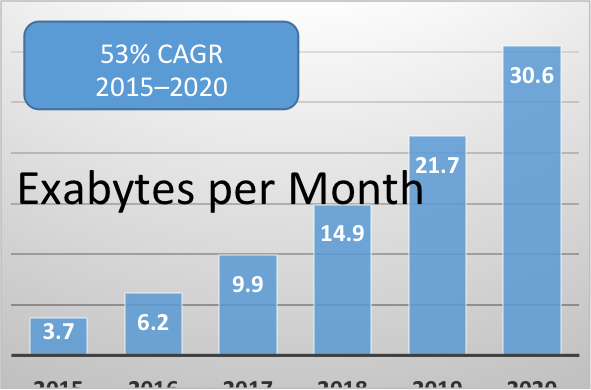
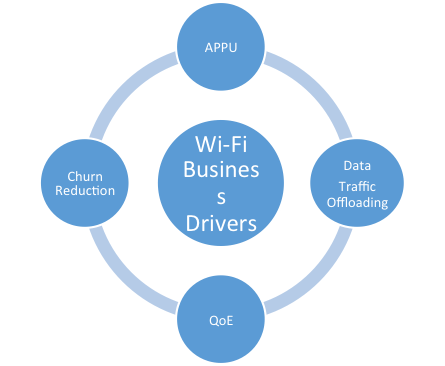
Trusted versus Untrusted Wi-Fi Access
Trusted access allows a secure network environment, encrypted Wi-Fi radio access, and a secure authentication method. In trusted access networks, the device (UE) is connected through a Trusted Wireless Access Gateway (TWAG); the VoWi-Fi call is terminated on the ePDG and then passed to the Packet Gateway (P-GW) in the Evolved Packet Core through a secure tunnel. In this model, subscribers connect via the operator’s trusted network and enjoy several benefits:
- RF management: less jitter, latency and error rates that enable better voice and data on Wi-Fi.
- SIM/Certificate-based authentication, which simplifies Wi-Fi connections, enabling transparent, access to the network.
- Network quality of service (QoS): ability to manage traffic flows.
- Service velocity by quickly deploying Wi-Fi where the users are, improving coverage.
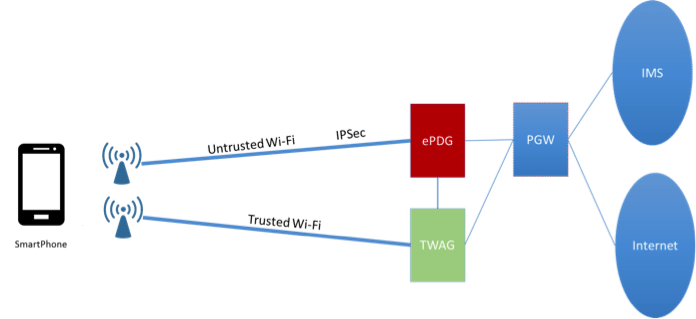
Untrusted access networks, such as broadband DSL, fiber to the home, high-density venues or cable broadband networks, are also using Wi-Fi as an access technology. In the untrusted model, the device and the evolved Packet Data Gateway (ePDG) use IPSec for data integrity and protection. The ePDG is then connected to the P-GW via a secure tunnel. Roaming users may also use untrusted access when using the public Internet to connect to their home operator before the traffic is routed to the core network.
Although in both cases VoWi-Fi is enabled, the main difference between trusted and untrusted Wi-Fi is that the first case allows for control of the user’s experience and better QoS management, as the SP owns and manages the Wi-Fi network (or partners with a Wi-Fi provider with defined service level agreements). Overall, this allows for better network utilization and policy control to optimize the user’s QoE while also maximizing the SP’s revenue opportunity (APPU).
SPs need to deploy the right architectural mix (Wi-Fi/macro/small-cell/femto) to optimize VoWi-Fi, but at the same time ensure the QoE and guarantee service availability. Challenges for consideration include:
- Managing the Wi-Fi quality (error rates, jitter and latency), generating high mean opinion scores for VoWiFi calls.
- Simplifying user access to Wi-Fi networks (SIM based authentication), making Wi-Fi connectivity transparent.
- Increasing Wi-Fi availability for users (home, office and hotspots), ensuring better VoWi-Fi and data offload.
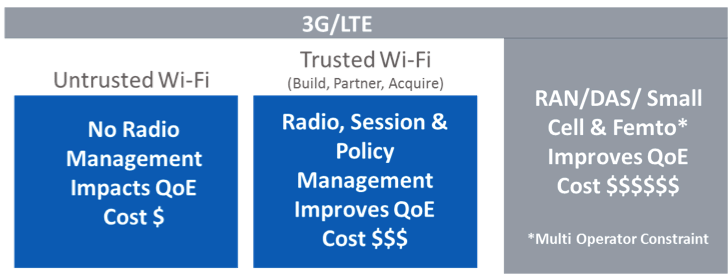
To address these challenges, the next phase of VoWi-Fi deployment must focus on trusted Wi-Fi architectures where the QoE can be controlled. SPs can build their own, partner with existing Wi-Fi providers or acquire Wi-Fi networks to increase the VoWi-Fi penetration on their networks. An SP can drive down costs and maximize APPU only by actively focusing on driving their users to Wi-Fi.
Business Case
The business case is mainly modeled by capturing network costs, spectrum costs, and the type of access in the network. Another important parameter modeled is the access point penetration rate, the smartphone penetration, and the growth of VoWi-Fi enabled devices over five years. Various assumptions have been made regarding the offloading percentage per region and the VoWi-Fi penetration growth in the network.
Some important input variables collected and calculated using major operator’s data per region include:
- Business and subscriber data (EBITDA, ARPU).
- Mobile subscribers (Subs base, minutes of usage).
- Coverage related data (2G/3G/4G coverage, number of base stations).
The model integrates all types of voice traffic, VoLTE, 2G, 3G and VoWiFi but emphasizes two different types of Wi-Fi traffic, trusted and untrusted. When combining different percentages of traffic in each scenario, it is easier to understand network impact and business performance. At the same time, VoLTE remains a competitive technology with growing penetration in service providers’ networks. Wi-Fi and VoLTE are growing at different rates, reflecting the difference in cost per minute, which has a direct impact on the SP’s opex, overall EBITDA performance. SPs need to efficiently seek the lowest opex by optimizing the mix of trusted Wi-Fi, untrusted Wi-Fi and licensed technologies.
An important element of trusted Wi-Fi traffic is that when the penetration dominates VoLTE and untrusted traffic, the cost per minute drops and the EBITDA margin is higher, creating an opportunity for the SP in Years 4 and 5 to maximize APPU, offer a higher QoE, and better manage the user’s expectations.
In the scenarios, a developed country with mature VoLTE penetration was used. The impact of VoWi-Fi combined with a mix of trusted and untrusted Wi-Fi was computed. The results show that APPU is maximized when the quality of VoWi-Fi is high (resulting in increased usage) and data offload is easily available (resulting in lower cost per bit).
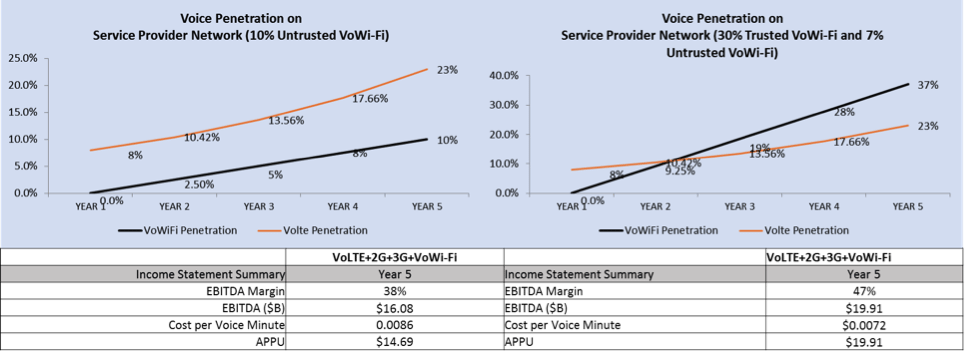
In the first scenario, the service provider’s network is 10 percent untrusted VoWi-Fi and no trusted Wi-Fi. This results in a low adoption of VoWi-Fi due to quality and user experience issues. In the second scenario, the service provider’s network is 30 percent trusted VoWi-Fi and 7 percent untrusted VoWi-Fi, resulting in VoWi-Fi penetration that is higher than VoLTE. This combination delivers $19.91 billion EBITDA (24 percent higher as compared to the first scenario) and a monthly APPU of $19.91 (35.5 percent higher as compared to the first scenario) with both ramping to Year 5. As VoWi-Fi grows the cost per voice minute drops, reaching a value of $0.0072. In the first scenario the service provider’s network is dominated by VoLTE penetration, resulting in the cost per voice minute being 19.5 percent higher than the second scenario.
Conclusion and Future Considerations
With declining ARPUs and EBITDAs, SPs need to take action. In the short term, deployment of VoWi-Fi and data offload strategies utilizing trusted Wi-Fi networks will benefit the home, work, and public space coverage problem. Trusted Wi-Fi offers the delivery of well-designed, managed, policy and radio-driven networks to help realistically generate higher levels of APPU by increasing VoWi-Fi adoption and lowering data transport costs. A Wi-Fi platform also offers the possibility for new service creation such as gaming, video delivery and Internet of Things innovations. These innovations will not only provide for competitive differentiation, but will also move the SP up the value chain, resulting in APPU growth.

